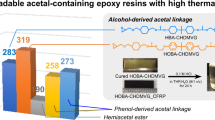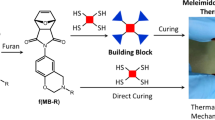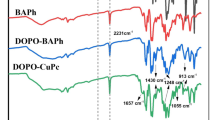Abstract
To develop a novel organic catalyst that can effectively cure cyanate ester resins, the effects of incorporating various phenolic compounds on the curing of bisphenol A dicyanate (BADCY) was investigated. Differential scanning calorimetry (DSC) and Fourier transform infrared (FT-IR) spectroscopy analyses revealed that o-(dimethylamino)methylphenol (o-DAMP) was a highly effective catalyst for accelerating the curing of BADCY, and the addition of o-DAMP reduced the final curing temperature of BADCY to 180 °C. The promoting effect of o-DAMP was found to be due to the presence of an acidic phenolic OH group and a basic (dimethylamino)methyl group at the ortho-positions of the molecule. The addition of o-DAMP improved the modulus, strength and fracture toughness (KIC) of the cured BADCY resins. The mechanical and thermal properties of the cured resins could be adjusted by changing the amount of o-DAMP.
This is a preview of subscription content, access via your institution
Access options
Subscribe to this journal
Receive 12 print issues and online access
$259.00 per year
only $21.58 per issue
Buy this article
- Purchase on Springer Link
- Instant access to full article PDF
Prices may be subject to local taxes which are calculated during checkout











Similar content being viewed by others
References
Sato H, Nabae Y, Hayakawa T, Kakimoto M. Synthesis and characterization of novel arylene cyanate resins. J Photopolym Sci Technol. 2013;26:373–6.
Zhang X, Wang F, Zhu Y, Qi H. Cyanate ester composites containing surface functionalized BN particles with grafted hyperpolyarylamide exhibiting desirable thermal conductivities and a low dielectric constant. RSC Adv. 2019;9:36424–33.
Lin Y, Song M. Effect of polyhedral oligomeric silsesquioxane nanoparticles on thermal decomposition of cyanate ester resin. React Funct Polym. 2018;129:58–63.
Ma P, Dai C, Jiang S. Thioetherimide-modified cyanate ester resin with better molding performance for glass fiber reinforced composites. Polymers. 2019;11:1458.
Zhang Z, Xu W, Yuan L, Guan Q, Liang G, Gu A. Flame-retardant cyanate ester resin with suppressed toxic volatiles based on environmentally friendly halloysite nanotube/graphene oxide hybrid. J Appl Polym Sci. 2018;135:46587.
Matallana A, Ibarra E, López I, Andreu J, Gerate JI, Jordà X, et al. Power module electronics in HEV/EV applications: New trends in wide-bandgap semiconductor technologies and design aspects. Renew Sustain Energy Rev. 2019;113:109264.
Fang T, Shimp DA. Polycyanate esters: science and applications. Prog Polym Sci. 1995;20:61–118.
Fang Z, Wang J, Gu A. Structure and properties of multiwalled carbon nanotubes/cyanate ester composites. Polym Eng Sci. 2006;46:670–9.
Wang J, Liang G, Zhao W, Lü S, Yan H. Modification of bisphenol A dicyanate ester by carboxyl-terminated liquid butadiene-acrylonitrile and its composites. Polym Eng Sci. 2006;46:581–7.
Gu A. High performance bismaleimide/cyanate ester hybrid polymer networks with excellent dielectric properties. Comp Sci Technol. 2006;66:1749–55.
Liang K, Li G, Toghiani H, Koo JH, Pittman CU. Cyanate ester/polyhedral oligomeric silsesquioxane (POSS) nanocomposites: synthesis and characterization. Chem Mater. 2006;18:301–12.
Anuradha G, Sarojadevi M. Synthesis and characterization of poly(arylene ether) containing cyanate ester networks. J Polym Res. 2008;15:507–14.
Huang P, Gu A, Liang G, Yuan L. Curing behavior and dielectric properties of hyperbranched poly(phenylene oxide)/cyanate ester resins. J Appl Polym Sci. 2011;121:2113–22.
Lin C, Yuan L, Gu A, Chen F, Liang G. High performance cyanate ester resins/reactive porous polymeric microsphere systems with low-temperature processability. Compos Sci Technol. 2013;85:148–55.
Ma J, Lei X, Tian D, Yuan L, Liao C. Curing behavior and network formation of cyanate ester resin/polyethylene glycol. J Appl Polym Sci. 2015;132:41841.
Chen X, Liang G, Gu A, Yuan L. Flame retarding cyanate ester resin with low curing temperature, high thermal resistance, outstanding dielectric property, and low water absorption for high frequency and high speed printed circuit broads. Ind Eng Chem Res. 2015;54:1806–15.
Kobayashi T, Isono M, Oyama T, Takahashi A. High performance cyanate ester resins modified with epoxy resins using novel catalyst. J Network Polym, Jpn. 2012;33:130–9.
Liang G, Ren P, Zhang Z, Lu T. Effect of the epoxy molecular weight on the properties of a cyanate ester/epoxy resin system. J Appl Polym Sci. 2006;101:1744–50.
Wang MW, Jeng RJ, Lin CH. Origin of the rapid trimerization of cyanate ester in a benzoxazine/cyanate ester blend. Macromolecules. 2015;48:2417–21.
Johansson A, Löfberg C, Antonsson M, von Unge S, Hayes MA, Judkins R, et al. Discovery of (3-(4-(2-oxa-6-azaspiro[3.3]heptan-6-ylmethyl)phenoxy)azetidin-1-yl)(5-(4-methoxyphenyl)-1,3,4-oxadiazol-2-yl)methanone (AZD1979), a melanin concentrating hormone receptor 1 (MCHr1) antagonist with favorable physicochemical properties. J Med Chem. 2016;59:2497–511.
Bauer M, Bauer J, Kühn G. Kinetics and modelling of thermal polycyclotrimerization of aromatic dicyanates. Acta Polym. 1986;37:715–9.
Iijima T, Katsurayama S, Fukuda W, Tomoi M. Modification of cyanate ester resin by poly(ethylene phthalate) and related copolyesters. J Appl Polym Sci. 2000;76:208–19.
Fujita H, Hayakawa N, Kunishima M. Study of the reactivities of acid-catalyzed O-benzylating reagents based on structural isomers of 1,3,5-triazine. J Org Chem. 2015;80:11200–5.
Lin K-F, Shyu J-Y. Early cure behavior of a liquid dicyanate ester resin. J Polym Sci: Part A: Polym Chem. 2001;39:3085–92.
Chang J-Y, Hong J-L. Polycyanurates modified with hydroxyl-terminated or cyanated poly(ether sulfone). Polymer. 2001;42:1525–32.
Kim M, Ko H, Park S-M. Synergistic effects of amine-modified ammonium polyphosphate on curing behaviors and flame retardation properties of epoxy composites. Compos B: Eng. 2019;170:19–30.
Zhang J, Xu S. Effect of chain length of cardanol-based phenalkamines on mechanical properties of air-dried and heat-cured epoxies. Mater Express. 2019;9:337–43.
Khorshidi S, Karkhaneh A, Bonakdar S, Omidian M. High‐strength functionalized pectin/fibroin hydrogel with tunable properties: A structure–property relationship study. J Appl Polym Sci. 2020;137:48859.
Ochi M, Yamashita K, Yoshizumi M, Shimbo M. Internal stress in epoxide resin networks containing biphenyl structure. J Appl Polym Sci. 1989;38:789–99.
Author information
Authors and Affiliations
Corresponding author
Ethics declarations
Conflict of interest
The authors declare that they have no conflict of interest.
Additional information
Publisher’s note Springer Nature remains neutral with regard to jurisdictional claims in published maps and institutional affiliations.
Supplementary information
Rights and permissions
About this article
Cite this article
Izu, K., Tokoro, Y. & Oyama, T. Curing acceleration of cyanate ester resin by a phenolic compound having a tertiary amino group at the ortho-position. Polym J 52, 1245–1252 (2020). https://doi.org/10.1038/s41428-020-0380-3
Received:
Revised:
Accepted:
Published:
Issue Date:
DOI: https://doi.org/10.1038/s41428-020-0380-3



